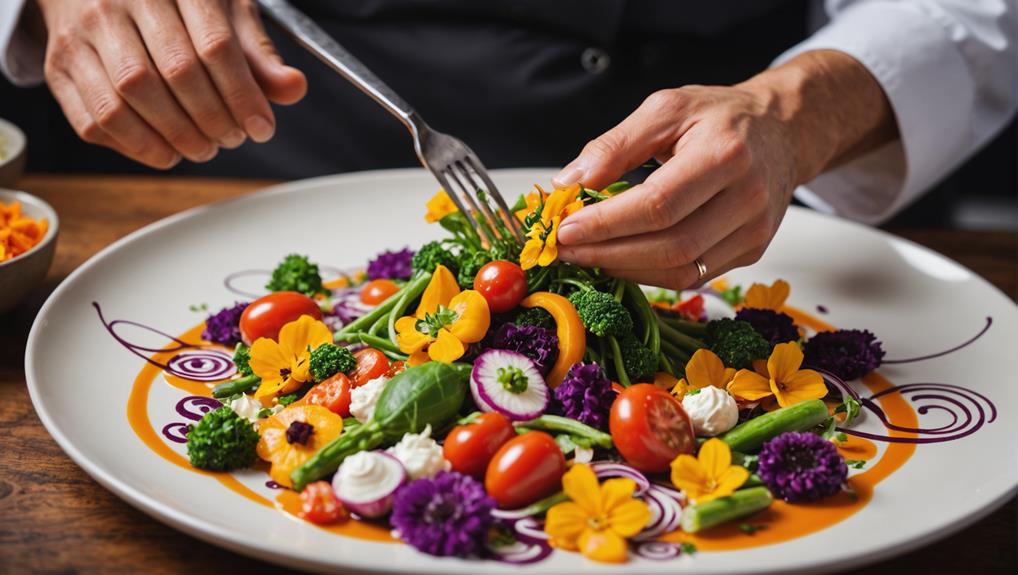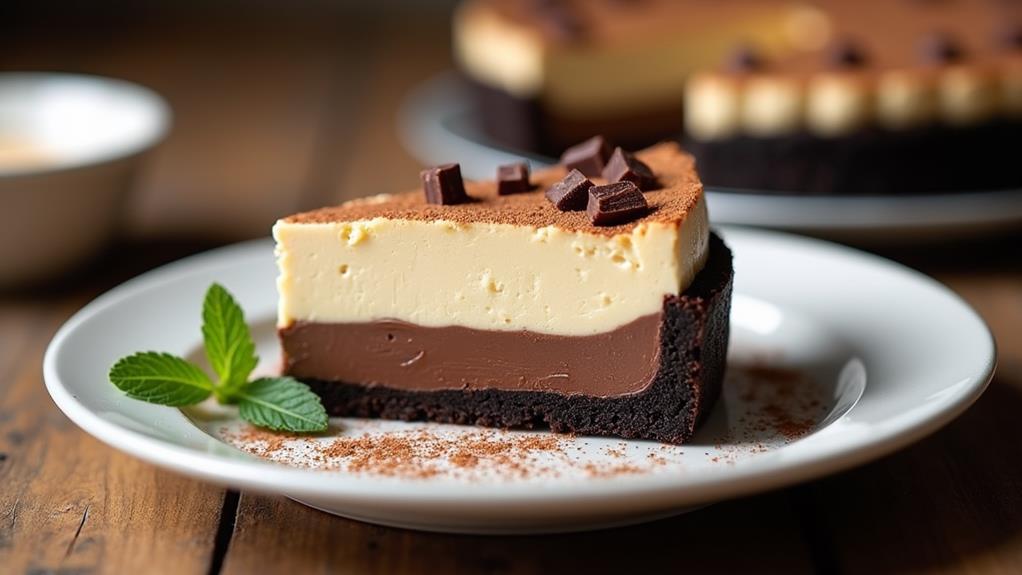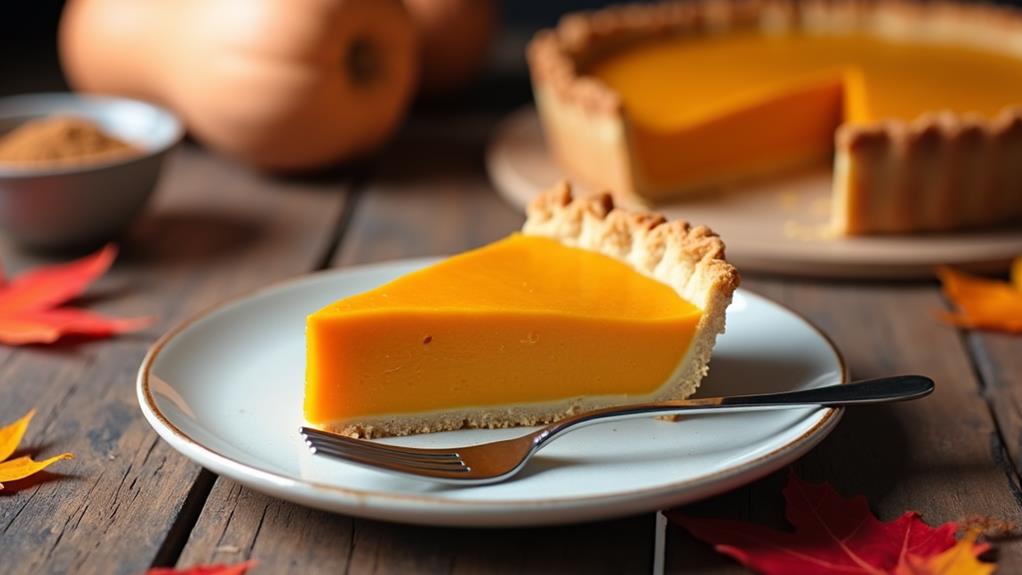Transform your dishes into visual masterpieces by mastering food styling techniques. Apply the rule of thirds for dynamic compositions, and use vibrant colors and contrasting textures to create appealing palettes. Experiment with lighting angles to showcase your creations optimally. Achieve balance through symmetry or strategic asymmetry, and incorporate height variations for depth. Curate colors thoughtfully, using seasonal ingredients and complementary hues from the color wheel. Garnish with precision, using tools like squeeze bottles and tweezers for artistic flair. Remember, negative space is crucial to prevent clutter and allow your main dish to shine. These fundamentals will elevate your plating skills to new heights.
Mastering Visual Appeal Fundamentals
When it comes to food presentation, mastering visual appeal fundamentals is essential. To create a culinary masterpiece that captivates the eye, you'll need to harness the power of food styling techniques.
Start by understanding composition principles, such as the rule of thirds, which will help you arrange elements on the plate for maximum impact. For instance, when plating a refreshing watermelon feta salad, consider presenting it in hollowed-out watermelon halves to enhance its visual allure. Pay attention to detail, using tools like tweezers to perfect each component's placement.
Next, focus on incorporating vibrant colors that make your dish pop. Experiment with contrasting hues and complementary shades to create a visually striking palette. The combination of the bright red watermelon and the white feta already offers an eye-catching contrast.
Don't forget the importance of textures that make your creation come alive – mix smooth with crunchy, or glossy with matte surfaces.
Your lighting setup plays a crucial role in showcasing your dish. Experiment with different angles and intensities to highlight key features and create depth.
Harmonizing Balance and Symmetry
Achieve a harmonious balance in your food presentation by mastering symmetry and asymmetry. The key to creating visually appealing dishes lies in understanding how to arrange elements strategically.
Embrace the rule of thirds to guide your composition, placing key components along imaginary grid lines to engage viewers' eyes. Don't shy away from asymmetrical displays; they can inject dynamism and interest into your culinary creation.
Elevate your presentation by incorporating height variations. Use risers or pedestals to create a cascading effect, adding depth and drawing attention to specific elements. This technique transforms a flat display into a multi-dimensional visual feast.
Complement your food arrangement with carefully chosen decorative elements. Linens, tableware, and thematic decorations can enhance the overall symmetry and cohesion of your display.
Curating Colors and Textures
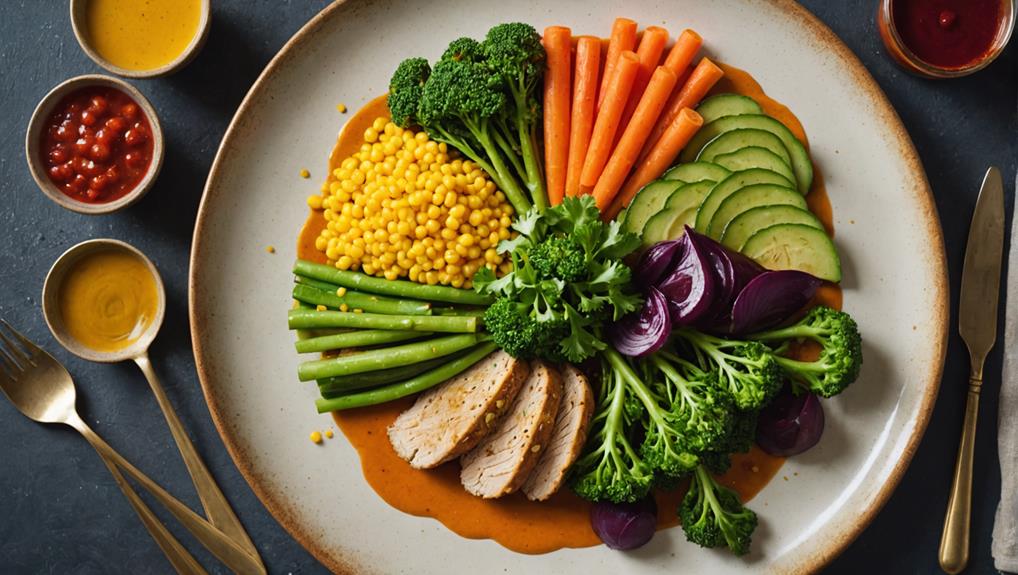
Beyond balance and symmetry, the visual impact of your dish hinges on a thoughtful curation of colors and textures. When curating colors for visually appealing food, consider using vibrant colors like reds and greens to stimulate appetite and enhance the perception of freshness.
For instance, incorporating seasonal ingredients like apples in an Autumn Harvest Salad not only adds richness in color but also brings fall flavors to your table. Utilize a color wheel to guide your selection of complementary or analogous hues, creating harmonious compositions that captivate diners' attention.
Incorporate a variety of textures to add depth to your dishes. Combine creamy, crunchy, and crispy elements to engage both the eyes and palate. This multisensory approach elevates your presentation and makes the dining experience more enticing.
Don't overlook the power of garnishes. Fresh herbs and edible flowers introduce pops of color and interesting textures, transforming your dish into a visual feast.
These small additions can significantly enhance the overall appeal of your creation.
Garnishing With Artistic Flair
Garnishing with artistic flair is the final touch that transforms a well-prepared dish into a visual masterpiece. You'll want to focus on creating visual appeal by incorporating vibrant colors and contrasting textures that stimulate appetite and elevate the dining experience.
In the realm of grilled dishes, consider using colorful sauces like chimichurri to complement the vibrant grilled vegetables. Don't hesitate to use fresh herbs, edible flowers, and colorful sauces as garnishes. These not only add aesthetic value but also enrich flavor profiles, making your dishes more enticing.
To achieve balance and harmony on the plate, strategically place garnishes to draw attention to focal points. For instance, a sprig of parsley or a drizzle of balsamic reduction can guide the eye. Utilize tools like squeeze bottles for sauces and tweezers for delicate garnishes to achieve precision in presentation. This allows you to create intricate designs that captivate viewers.
Experiment with height and layering to add depth to your presentations. By doing so, you'll transform simple dishes into visually striking culinary masterpieces.
Polishing Precision Plating Techniques
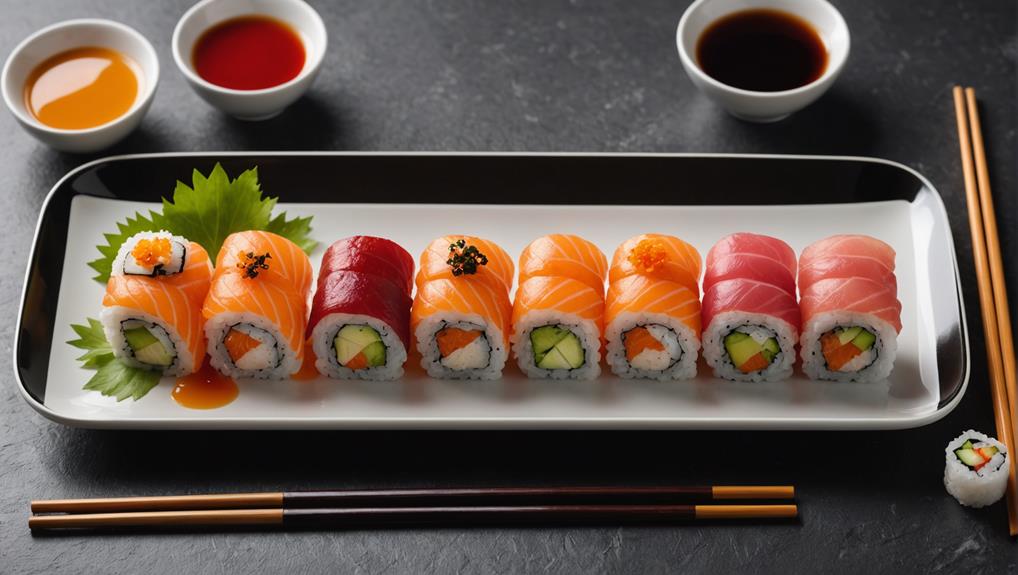
How can you elevate your culinary creations through precision plating? In the culinary world, visual appeal is just as important as taste. To transform your dishes into visual masterpieces, embrace the art of precision plating.
Start by applying the rule of thirds, dividing your plate into a grid and placing key elements along these lines to create a dynamic composition. Incorporate height variation by stacking ingredients or using risers, adding depth and intrigue to your presentation.
Don't forget the power of negative space; clean lines and intentional blank areas prevent clutter and allow your main dish to shine as the focal point.
When it comes to garnishes, choose fresh, complementary elements that enhance both flavor and aesthetics. Herbs, sauces, or edible flowers can add pops of color and texture, elevating your dish's overall appeal.
Frequently Asked Questions
How Do I Present My Food to Make It Look Visually Appealing?
To make your food visually appealing, focus on color contrasts and texture variety. Choose appropriate plates, apply garnish techniques, and use layering methods. Consider portion sizes, serving ware, and lighting effects. Experiment with arrangement styles and seasonal themes for innovative presentations.
How Do I Make My Food Look Appealing?
Tired of serving slop? Elevate your grub with color contrast, smart plate choice, and clever garnish techniques. Arrange ingredients artfully, play with lighting effects, and vary textures. Don't forget stylish utensils, balanced portions, and fresh displays. Embrace thematic decor for maximum appeal.
Why Is Aesthetics Important in Food Presentation?
Aesthetics in food presentation captivates your senses, enhancing flavor perception. You'll experience a visual feast through color contrast, texture variety, and cultural influences. Plate choice, garnishing techniques, and lighting effects create visual balance, elevating your dining experience to new heights.
What Is the Role of Food Styling in Mass Media?
Food styling in mass media elevates culinary artistry through visual storytelling. You'll see it shaping brand identity, driving audience engagement, and influencing trends. It's a powerful marketing strategy that creates sensory experiences, represents cultures, and fuels your desire for innovative cuisine.
Final Thoughts
You've now got the tools to turn your dishes into eye-catching masterpieces. Remember, practice makes perfect, so don't be afraid to experiment with these techniques. As you refine your skills, you'll find that plating becomes second nature. Soon, you'll be creating stunning presentations that'll make your guests' mouths water before they even take a bite. Keep pushing the envelope, and you'll be plating like a pro in no time.

